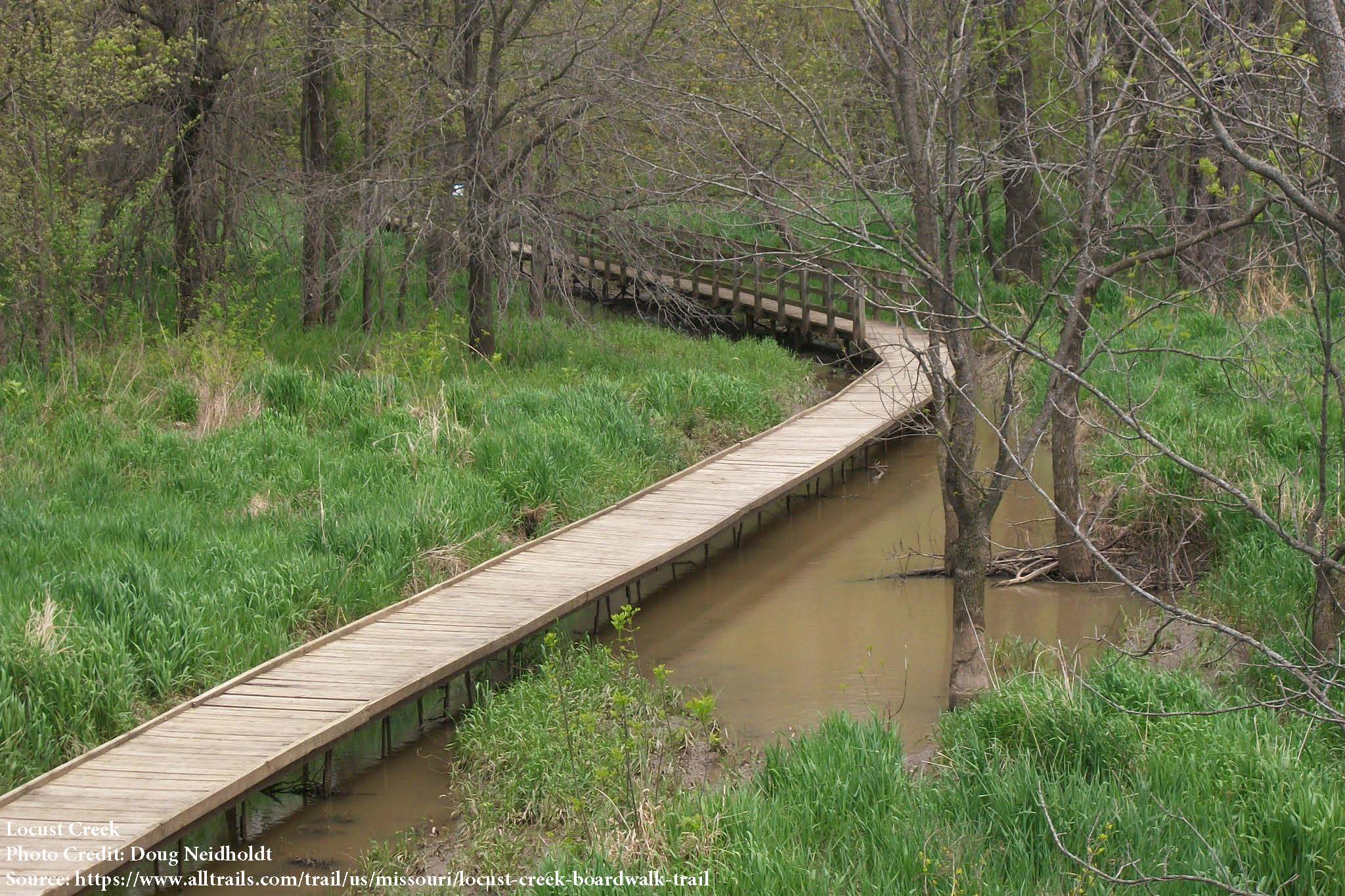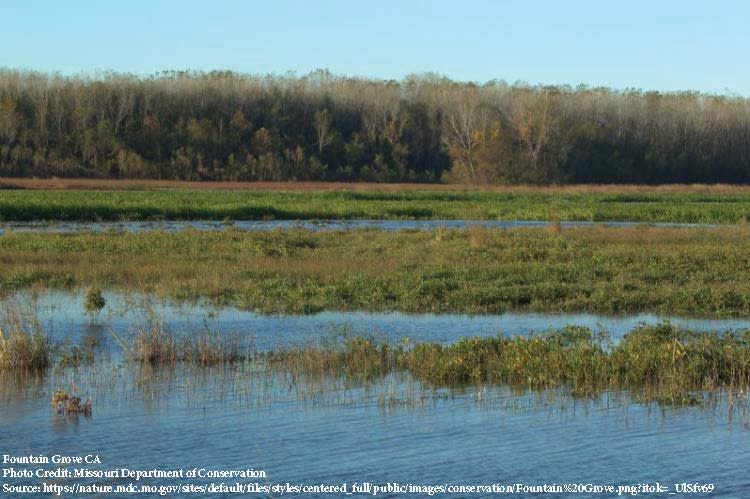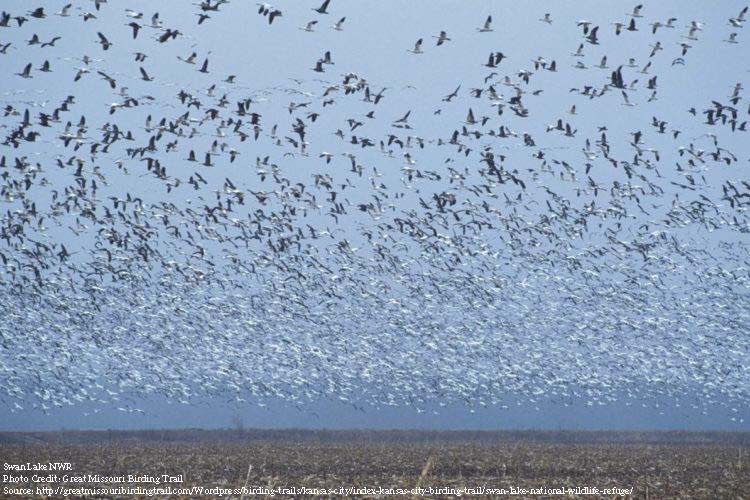
Lower Grand River Wetland Conservation Opportunity Area (COA)
About
GENERAL INFORMATION
Criteria:
- Protects biological diverse wetland flora, fauna and/or their habitat
- Supports significant numbers of wetland-dependent fauna, such as water birds or fish
- Rare or unique wetland type within its own biogeographical region. (Meeting this criteria would include, but is not limited to, wetlands with unique hydrology or chemistry that make it rare within its own region)
Spanning over 53,268 hectares, the Lower Grand River Wetland Conservation Opportunity Area (COA) in north-central Missouri contains a unique combination of floodplain geology, soil and elevation configuration, and hydrological attributes that contribute to the region’s great biodiversity and high productivity. The area contains a combination of 2,400 acres of native bottomland forest, 600 acres of cordgrass prairie, intermixed by shrub swamp, slough, marsh, and oxbow lakes. Wet prairies, a critically imperiled community type in Missouri, can be also be found within the Lower Grand River Wetland COA.
The Lower Grand River Wetland COA includes Swan Lake National Wildlife Refuge (NWR) managed by the U.S. Fish and Wildlife Service (USFWS), Pershing State Park operated by the Missouri Department of Natural Resources (MDNR), and Fountain Grove and Yellow Creek Conservation Areas managed by the Missouri Department of Conservation (MDOC). Together, these managed areas, wetlands, and associated uplands provide vital habitat for migrating waterfowl, shorebirds, and many other wetland dependent species, representing some of the most premier wetland habitat in the Midwest. Moreover, these areas have important natural resources and a rich diversity of native species. Each of these areas is known for restored wetlands and associated plants, insects, amphibians, reptiles, birds, and migrating waterfowl. Hunting for deer, turkey, and waterfowl are top recreational activities within the area. Other recreational opportunities include fishing, wildlife observation, photography, environmental education, and interpretation.
Because the Lower Grand River Wetland COA is a nationally recognized migratory bird wintering area with unique and ecologically important wildlife habitat that includes remnant riverine and wetland natural communities once present in northern Missouri, this wetland complex should be considered a national Wetland of Distinction.
Exemplary Ecosystem Services:
- Maintains ecological connectivity/cohesion
- Recreation (birdwatching, ecotourism)
- Flood storage/mitigation
- Education
CONSERVATION STATUS AND THREATS
Public Access: Yes
Current and Future Threats: Pest Plants and animals (current with a control plan in place); water quality (control plan in place) and Climate change (future with water management strategies being developed and implemented to mitigate and adapt to potential changes)
Conservation status: Other
Adjacent Land Use: Agricultural (cropland, orchards, greenhouse)
Approximate natural buffer width:
- 50-100 ft
Other Information: Both Federally and State protected (National Wildlife Refuge, State Park, and Conservation Areas)
The Lower Grand River Wetland COA has a rich history. It is home to the Locust Creek Covered Bridge State Historic Site, the longest of four remaining covered bridges in the state of Missouri; a gem that is listed on the National Registrar of Historic Places in 1970.
Missouri was one of nine states to first enroll in the U.S. Department of Agriculture’s (USDA) Wetlands Reserve Program (WRP). The WRP is one of a host of voluntary conservation programs for landowners that are supported and administered by the USDA’s Natural Resources Conservation Service (NRCS). The goal of the WRP is to maximize wetland functions and values, and optimize wildlife habitat “on every acre enrolled…” Whereas the Program is national in scope, Missouri is one of the leading states in both number and area of easements enrolled. Chariton County has the largest acreage of enrollment in the WRP program in Missouri. These private easements are managed throughout the Lower Grand River Wetland COA, and they provide some of the best restored wetland habitat in the state.
ECOLOGY
Approximate size: 53,268 hectares
General wetland characterization:
- Inland Fresh Seasonally Flooded Basin/Flat
- Inland Fresh Meadow
- Inland Shallow Fresh Marsh
- Inland Open Fresh Water
- Inland Fresh Shrub Swamp
- Inland Fresh Wooded Swamp
Adjacent Water Bod(ies):
- Lake
- Pond
- Stream
Surficial Geology:
The geology of the area consists of cyclic deposits of Pennsylvanian carbonates, shale and sandstone with minor coal overlain by glacial deposits (loess, till, etc.). Water infiltration through the subsurface is limited by these sequences of geologic strata. No sinkholes or caves have been documented in the basin. Groundwater quality is poor, and no high yield potable bedrock aquifers are available. Wells that terminate in the glacial till above bedrock are low yielding. Only two springs have been documented in the basin. Water movement in the basin is predominantly through the surface stream network and stream base flow is very low during dry periods.
Soils:
Soils in the Lower Grand River region are mostly alluvium derived from a mixture of loess and glacial till eroded from upland terraces adjacent to floodplains. Soil texture and drainage in the Lower Grand River region vary in relation to position within the alluvial plain or adjacent terraces. Typically, soils nearest the stream/river channels have coarser texture and are moderately to well -drained such as the silty Nodaway, Tice, Dockery, and Wabash soil series. Soils in floodplain depressions and backswamp sites contain mostly clay surfaces and are poorly drained, such as the Zook and Carlow series. Broad transition areas are transitional in texture and drainage, such as the Colo series. Floodplain soils in the Lower Grand River region are neutral to strongly acidic, with no free carbonate rocks. Loess silt loam soils cover most of the broad gently sloping Grand River Hills. Loess has a very low sand content and most soils in this area have silt loam surfaces with silty clay loam or silty clay subsoil. Most soils adjacent to, and on higher elevations in the Lower Grand River region were formed under prairie vegetation and have thick, dark layers. These soils are dominated by Booker, Kennebec, and Dockery silt clay and silt loam types. Soils that formed under savanna or prairie-forest transition areas have thinner surface layers, particularly on lower slopes. Most prairie-type soils have seasonally perched water tables within the clayey subsoil, which dry in summer.
FLORA AND FAUNA
Dominant flora: The Lower Grand River Wetland COA is partially comprised of large stretches of bottomland forest, generally occurring on wet soil and floodplains. Vegetation is generally dominated by pin oak, silver maple, swamp white oak, shellbark hickory, and shagbark hickory with green ash, bur oak, elm, black willow, river birch, and honey locust are important species. The understory varies from open areas dominated with a shrub layer composed of Missouri gooseberry, western snowberry, and common pricklyash. The Lower Grand River Wetland COA is also comprised of thousands of acres of emergent wetland habitat. Common perennial plants found in these emergent wetlands include cattail, bulrushes, arrowheads, and sedges. Wet meadows within the Lower Grand River Wetland COA are home to water-loving grass species, sedges, rushes, and wetland wildflowers. Shrub swamps, occurring along the perimeter of wetland habitats are dominated by buttonbush, willow, and an underlying mix of sedges, grasses, and emergent vegetation. The 2011 Swan Lake NWR Comprehensive Conservation Plan provides a species list of just some of the plant that can be found in the Lower Grand River Wetland COA.
Unique flora: Within the Lower Grand River Wetland COA, wetland prairies at Pershing State Park shelter the uncommon pale green orchid. Additionally, the 2011 Swan Lake NWR Comprehensive Conservation Plan documents the occurrence of the following rare plant species in the Lower Grand River Wetland COA: coast cockspur (Echinochloa walteri), whitedge flatsedge (Cyperus flavicomus), and Arkansas sedge (Carex arkansana). Lastly, wetlands around Locust Creek support the rare ostrich fern (Matteuccia struthiopteris).
Dominant fauna: The Lower Grand River Wetland COA is home to a wide variety of wildlife species including mammals, birds, fish, invertebrates, amphibians, and reptiles. The 2011 Swan Lake NWR Comprehensive Conservation Plan provides a species list of just some of the wildlife that can be found in the Lower Grand River Wetland COA. Forty-six different mammalian species are documented to occur within the Swan Lake NWR, which comprises only a portion of the Lower Grand River Wetland COA. Mammals that can be found in the Lower Grand River Wetland COA include the white-tailed deer, gray fox, striped skunk, river otter, bobcat, red fox, coyote, badger, mink, long-tailed weasel, least weasel, Franklin’s ground squirrel, fox squirrel, plains pocket gopher and a wide variety of bat and rodent species. The Lower Grand River Wetland COA is also home to a large number of bird species. The majority of the Lower Grand River Wetland COA is designated as an Important Bird Area (IBA), areas that are vital to birds and other biodiversity. The Lower Grand River Wetland IBA provides grassland bird habitat and riparian woodlands for arboreal nesting species, including bald eagles, rookeries for great blue herons, red-headed woodpeckers, Acadian flycatchers, prothonotary warbler, and wood thrush. American bitterns are common during migration and least bitterns have been observed to nest in the IBA. Pied-billed grebes and red-shouldered hawks also nest on the Swan Lake NWR. Other wetland birds observed in the IBA include common moorhen, interior least tern, marsh wren, and sora. During migration and winter, the Lower Grand River Wetland IBA regularly supports large concentrations of waterfowl, and good numbers and diversity of shorebird species. In addition to bird habitat, the Lower Grand River Wetland COA provides species-specific habitat requirements for a variety of amphibians including, the central newt, small-mouth salamander, eastern tiger salamander, American toad and the great plains toad. More than twenty different snake species occur within the wetland complex include the diamondback watersnake, speckled kingsnake, lined snake, western ribbon snake, and the eastern hog-nosed snake. Turtles within the wetland complex include the red-eared slider, common snapping turtle, western painted turtle, three-toed box turtle, ornate box turtle, and the midland smooth softshell turtle. Common fish species within the Lower Grand River Wetland COA are channel catfish, black bullhead, yellow bullhead, common carp, river carpsucker, creek chub, red shiner, sand shiner and green sunfish. A variety of invertebrates can also be found in the wetland complex, including twenty species of butterflies and twenty-four species of odonates (darners, forktails, meadowhawks, and skimmers).
Rare fauna: An assessment of the Grand River watershed, reports that flat floaters (Anodonta suborticulata), trout-perch (Percopsis omiscomaycus), and mooneye (Hiodon tergisus), state listed as rare in Missouri, can be found in the Grand River basin. Additionally, the prairie massasauga rattlesnake is present within the COA.
.
ADDITIONAL INFORMATION:
Grand River Watershed Inventory And Assessment
CONTACT INFORMATION
Applicant First Name: Lindsey
Applicant Last Name: Postaski
Applicant E-mail Address: lindsey.postaski@parsons.com
Images


